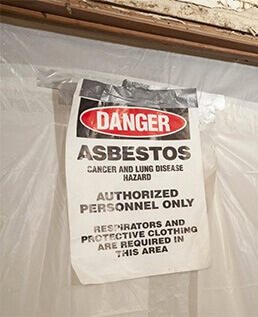When Does Asbestos Become Dangerous?
Posted in Asbestos Removal, on November 02, 2021
When it comes to asbestos, many people understand that the mineral poses a level of danger. But at the same time, there is some mystery surrounding the specifics of when, how, and why asbestos becomes a hazard. In some cases, asbestos is not an imminent risk, while in others it requires immediate attention. The safest decision for property owners is to rely on professional restoration services to use asbestos testing in Edmonton to identify the risk level of asbestos before determining whether or not asbestos removal in Edmonton is necessary.
At Canada’s Restoration Services, our team is certified and trained for asbestos inspections, testing, and removal in Edmonton. So, if you suspect that asbestos is somewhere within your property, you can call our team for fast, responsive asbestos removal in Edmonton.
When is Asbestos Not Dangerous?
.png) Asbestos removal in Edmonton is not always necessary depending on the condition in which asbestos-containing materials or ACMs are found. Canada’s Restoration Services conducts thorough inspections and asbestos testing in Edmonton and 3rd party labs for a complete analysis. Typically if asbestos is sealed or non-friable through encapsulation, then there is minimal risk of inhalation. However, even if asbestos removal is not required, asbestos in any condition should always be treated as a hazard.
Asbestos removal in Edmonton is not always necessary depending on the condition in which asbestos-containing materials or ACMs are found. Canada’s Restoration Services conducts thorough inspections and asbestos testing in Edmonton and 3rd party labs for a complete analysis. Typically if asbestos is sealed or non-friable through encapsulation, then there is minimal risk of inhalation. However, even if asbestos removal is not required, asbestos in any condition should always be treated as a hazard.
When Does Asbestos Become Dangerous?
If asbestos is not always dangerous, when does the mineral become a problem? Asbestos is dangerous when its fibers are disturbed and released into the air. Airborne asbestos fibers quickly divide, making them easy to inhale. Once ingested or inhaled, microscopic fibers can enter the lungs and call illness. Meaning asbestos is dangerous when it’s at risk of becoming disturbed and most hazardous when released in the air. Asbestos testing services in Edmonton seek to identify instances of the mineral around a property and commence asbestos removal in Edmonton before it goes airborne. For comprehensive asbestos removal in Edmonton, Canada’s Restoration Services will cover everything from inspections and testing to abatement and clean-up.
Naturally Occurring Asbestos
Asbestos is a mineral that was mined in the 20th century and used in building materials due to its abundance, durability, fire resistance, and affordability. In its natural form, asbestos is not dangerous when left alone. If asbestos is crushed or broken during mining or extraction, there is a risk associated with it. However, for the average person, this type of encounter with asbestos is highly unlikely. Asbestos is more likely to be encountered in building materials constructed between the 1960s - 1990s when the use of the mineral was incredibly popular. If you’re doing work in your attic, ducts, HVAC, or roofing, asbestos testing in Edmonton is a smart way to prevent any exposure.
Types of Asbestos
The risk of asbestos is affected by the type of asbestos encountered. There are six different variants of asbestos. The three that were used most commonly include white asbestos (chrysotile), blue asbestos (crocidolite), and brown asbestos (amosite). White asbestos was the most popular form, accounting for more than 90% of all commercial asbestos applications. Blue and brown asbestos, belonging to the amphibole family, are considered far more dangerous than white asbestos due to their rigid, needle-like fibers.
In most cases, close contact with asbestos in any application presents a significant risk. To be safe, professionals should always conduct asbestos testing in Edmonton as well as asbestos removal.







